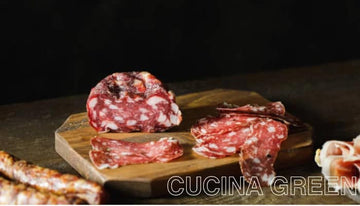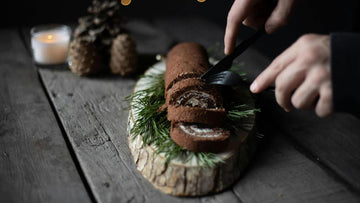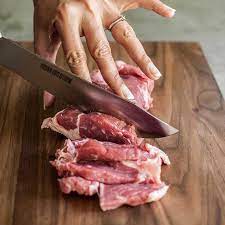
On the contrary, one type of wood that shines among others for its outstanding attributes is cherry wood.
Cherry wood cutting board is a good pick because cherry wood is beautiful and offers additional benefits.
This overview shall describe why cherry wood cutting boards should be preferred as they possess strength, enduring beauty, easy maintenance, etc. Therefore, let’s get started and find out why are cherry wood cutting boards outstanding?
The Beauty and Durability of Cherry Wood:
Cherry trees come in different varieties of trees which form part of the prunus genera of the rose family. Sweet cherries (Prunus avium) and black cherry trees (Prunus serotina) are the most utilized species of the tree. The wood from these trees is highly prized by woodworkers for its unique qualities.
Strength and Durability;
Cherry wood is a common selection to cut boards due to its high resistance. Cherry wood has a Janka hardness rating of 1,150 lbf for sweet cherry and 950 lbf for black cherry. Cherry wood can support daily use and it is soft enough not to harm the knife.
The cutting board has moderate hardness which prevents it from developing deep cuts due to knife use, thus preserving its integrity.
Cherrywood is a HardWood:
Cherrywood is a hardwood. Surprisingly, the Janka hardness scale indicates that cherrywood can be over 1,000 pounds per square inch in some cases.
It implies that one thousand pounds of pressure are required to drive home a .44-inch steel ball just 0.22 inches deep into the timber.
For example, as indicated in the Wood Database, these are the Harness ratings for other woods:
- 1150 pound force:sweet chery
- 950 pound force :Black cherry
- 1010 pound force :black walnut cherry
- 950 pound force :redwood
- 950 pound force: soft maple:
Tight Grain and Non-Toxic Nature:
Tight grain means that there are closely-packed fibers. The tight grain means that it is not very porous, and therefore it does not stain as much as if it was open grained.
Moreover, it creates some hurdles for the bacteria growth as compared with other wood types. On the other hand, cherry wood is a non-toxic substance used in food preparation without containing any poisonous compounds.
Timeless Elegance Of Cherry Wood Cutting Boards:
Aesthetics and Appeal:
Cherry wood cutting boards have high durability and beauty in design as they’ll never go old. Cherry wood has a warm, pinkish-brown hue, which makes it the best choice for any kitchen.
As cherry wood ages, it gradually acquires a pleasant reddish brown patina. Another oil would be a food safe one which would further enhance and highlight the beautiful straight grains that would give each unit of this product its own personality and visual appeal.
Versatility in Design:
The cherry wood cutting boards come in different designs for people with different tastes and kitchen themes that they want to match with.
These are edge-cut cherry wood cutting boards which give off a very simple, yet all-natural look along with food safe oil finish accentuating wood’s colours and bringing out the grain pattern.
However, there is more than meets the eye in the end-cut cherry wood cutting boards that have darker looks compared to the rest of the woods, as well as with varying shades of color.
Cherry wood is brought out in an artistic way, but not exaggerated, making the board an addition to any kitchen’s decoration.
Easy Cleaning and Maintenance:
Simple Cleaning Process:
It is vital that you keep your cutting board clean in order to maintain a healthy kitchen. The advantage of cleaning when made from cherry wood. Cleaning them manually is an easy process although they are not dishwasher safe.
Use warm water plus mild soap together with soft sponge or cloth and wipe the surface after every use.
Do not dunk the board in water and let it stay under water for a long time because these can lead to warping or damage of the board.
Natural Anti-Microbial Properties:
Cutting boards made of cherry wood or other types of wood also contain natural antimicrobials. The bacterial growth on the surfaces is restricted which leads to bacterial death immediately upon drying of the wooden slab.
Another reason is that the tight grain of a cherry wood allows no room for bacterial hiding and hence reduces the possibility of cross contaminations.
Periodic Maintenance:
Taking care of cherry wood cutting board will keep its beauty as well as preserving longevity. Apply a food safe mineral oil to the surface of the board every few weeks.
This keeps the woods’ natural oils replenished so that the wood does not dry up and split. Secondly, waxing the board using a food-safe wax forms a protective sheet that prolongs its life.
Different types of the cherry wood cutting board:
Cherry wood cutting boards can be purchased in a number of varieties. Here are a few popular options:
John Boos Cherry Wood Cutting Board:
The cutting board of solid cherrywood has a reversible design which includes hand grips to make transportation effortless.
Sonder Los Angeles Cherry Wood Cutting Board:
It is made from a single block of cherry wood and can be used as a cutting board, chopping board, and serving platters. They come in various forms with a wide range of options as per preference.
Plain Cherry Cutting Board:
The plain cutting boards of cherry wood come in a single form and its direction is either vertical or horizontal. End grain, edge grain, and TT boards are relatively thicker than cross-grain boards.
Live Edge Cherry Cutting Board:
Live edge cutting boards keep the organic form of the wood intact with its jagged edges resulting in a one-of-a-kind, rough look. You can also consider live edge cherry cutting boards as these enhance natural beauty in your kitchen.
Custom Cherry Cutting Board:
Several artisans and woodworkers provide personalised cherry cutting boards. The custom cut boards come in various sizes, thickness, and designs and thus allows for one unique cutting board.
Cherry Wood vs. Other Wood Cutting Boards:
Cherry Wood vs. Maple Cutting Boards:
Another popular cutting board material is maple wood, owing to its hardness and toughness. This notwithstanding; when comparing cherry wood and maple, each has its individual benefits.
Consequently, although cherry wood has a somewhat lower Janka hardness rating than other woods, it remains effective in cushioning knives without compromising toughness.
However, maple wood is tougher to make knife marks onit . In the end it is a matter of individual taste or requirements that will decide whether cherrywood is preferable to maple.
Cherry Wood vs. Acacia Cutting Boards:
Acacia is highly valued by the artisans because of the beautiful patterns and great strength properties that makes it ideal as cutting boards.
However, acacia wood is harder than cherry wood and therefore can cause knives to get dull faster.
Although an acacia will not show knife marks even after it becomes old, you should understand that cherry wood offers the best compromise between durability and beauty while remaining friendly to knives.
Cherry Wood vs. Birch Wood Cutting Boards:
Birch wood is a not very popular kind of wood for cutting board, however it also have benefits. Birch wood possesses medium Janka hardness rating that is not too different from that of cherry wood.
However, compared to birch it doesn’t have great resistance to moisture and change of humidity – that can be really fatal for its integrity.
In terms of durability and moisture resistivity, cherry wood comes out as a dependable option when it comes to making cutting boards.
Pros and cons of cherry wood as a cutting board material:
Pros:
- Rich colors and beautiful Natural antimicrobial properties
- long-lasting and Durability
- Easy to use
- Easy to wash
Cons:
- Need proper maintenance
- Little expensive
What things should be considered before buying a Cherry Wood Cutting Board?
when purchasing a cherry wood cutting board, several factors must be taken into consideration for both the board’s properties and proportions. Here are some important things to keep in mind:
Thickness:
Thickness of the cutting board also matters because of how tough it will be. Therefore, choose a board of at least one inch thickness so as to enhance its endurance and keep it against warping.
Size:
Remember that it will depend on your particular requirements and the dimensions of your kitchen. Have in mind, for instance, the foods you normally cook and the sizes of your knives.
The bigger board offers more surface area for cutting and the smaller one fits better on small counters.
Grain Orientation:
Take note of the direction in which the board grains are running. For example, end-grain cutting boards, which have vertical grain.
End-grade cutting boards are known for being kinder on knives and self healing by design. Edge grain cuting boards where in the grain runs horizontally and is equally tough but needs additional care.
Quality and Craftsmanship:
Buy a good quality cherry wood-cutting board created with care. Ensure such splinters are eliminated by seeking a fine sanded board; correctly finished one with smoothened edges.
These are some of the considerations you need to put in mind such as your requirements, preferences as well as kitchen space if you want to buy a cherry wood cutting board.
FAQs:
Are cutting boards made from cherry wood eco-friendly?
Sustainable cherry wood cutting boards are a possibility when wood is harvested from responsible forest management. The cherry woods used for cutting boards must be environmentally friendly or obtained from sustainably managed forests.
What tips can you provide for maintaining a cherry wood cutting board?
In other words, a cherry wood cutting board should be thoroughly cleaned in water that is slightly warm coupled with mild soap after every usage.
Do not immerse the board and apply natural oil-based (food safe) mineral oil occasionally to maintain moisture in the timber/wood. Applying food-safe wax onto the board can give extra safeguards as well.
Do cut-cherry boards acquire odors?
If the cherry wood cutting boards are not thoroughly washed and dried, they might acquire unwanted odors. Use a solution made up of lemon and salt, or any other food safe odor remover that is approved for cutting boards.
Conclusion:
In terms of selecting the best cutting board, cherry wood is a superior choice. It is strong, does not go out of fashion, easy to clean and cut well by a knife, so it is chosen by both working cooks and amateurs in everyday life.
Cherry Wood features aesthetic beauty in combination with its natural anti-microbial attributes to provide a safe and fashionable kitchen component.
Therefore, if you are in need of an efficient and beautiful chopping board, then think for a cherry wood cutting board as the most suitable for your cookery.




